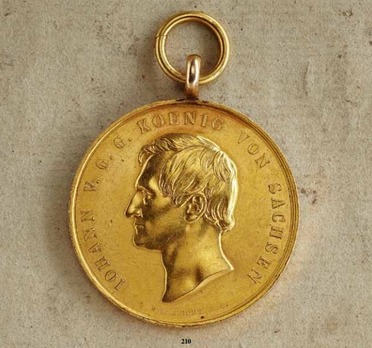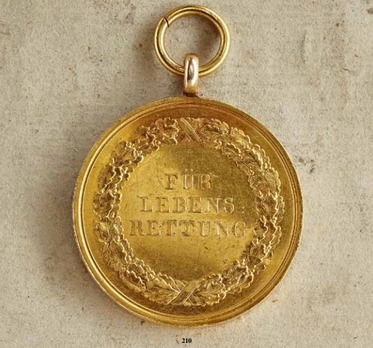Life Saving Medal, Type III, in Gold
CATEGORY: Version
SKU: 02.SXK.0117.101.01.000
Estimated market value:


Estimated market value:
A smooth circular medal with a raised edge, constructed of gold. The obverse features the left-facing head of King Johann with the circular inscription ‘JOHANN V. G. G. KOENIG VON SACHSEN’ (‘Johann von Gottes Gnaden Koenig von Sachsen’ = ‘Johann by God’s Grace King of Saxony’). At the bottom is the stamp cutter’s signature ‘C. ULBRICHT F.’. The reverse features the inscription ‘FÜR LEBENS=RETTUNG’ (‘for life saving’), surrounded by an oak leaf wreath that is cross-tied by a ribbon at the top and bottom. On a loop for suspension, on a white ribbon. 28 grams.
Life Saving Medals were awarded to individuals who risked their lives to rescue a person in mortal danger. The medal was originally founded by King Anton and his co-regent Friedrich August.
The Kingdom of Saxony was the first German state to use wearable life saving medals, followed by Prussia in 1833 and Braunschweig in 1836.
The Type III (1854-1873) medals feature the portrait of King John on the obverse. The reverse inscription reads "FÜR LEBENSRETTUNG" (for life saving). The die was cut by C. Ulbricht.
In 1862, a disaster in the quarry of Schmilka occured, when 24 stone crushers fell from the wall. The rescue took 56 hours, and all the victims were saved. On March 15, 1862, King Johann decreed the rescue work was particularly well done, and a specific Silver Life Saving Medal was instituted for the parties involved.
The Gold Medal was made of eight ducats. The die cutter signature is often very thin and illegible. Friedrich Carl Christian Ulbricht was the official die cutter at the Royal Dresden Mint between 1848 and 1860.

Comments
Sign in to comment and reply.


Scroll Top